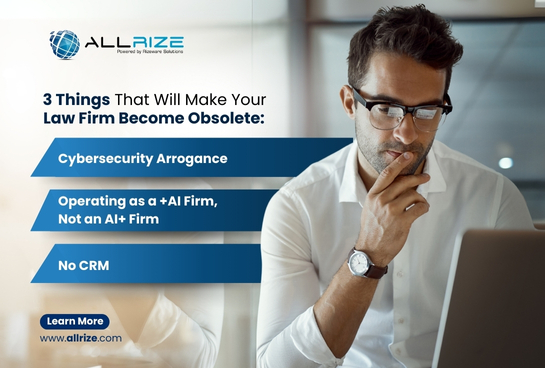Innovate or Die. While this phrase has mostly been used to describe businesses in competitive markets, it applies just as directly to the legal industry. As technology advances, client expectations will continue to change and firms that fail to evolve risk falling behind. Here are three things that will make your law firm obsolete by the end of 2025.
1. Cybersecurity Arrogance
They say there are two types of organizations: those that have been hacked and those that don’t know they’ve been hacked. Cybersecurity should be a top priority for law firms. Firms store ultra-sensitive personal data and are therefore targets of bad actors. The American Bar Association has recognized the importance of cybersecurity for law firms and developed a dedicated Cybersecurity Legal Task Force.
The most common attacks used to target law firms include:
- Phishing attacks: A malicious actor attempts to trick users into revealing sensitive information like passwords or credit card details by sending deceptive emails, text messages, or other communications that appear to be from a trusted source.
- DDoS attacks: Distributed denial of service attacks flood a network or server with overwhelming fake traffic, preventing legitimate users from accessing the service.
- Third-party attacks: A cyber attack that targets an organization by exploiting vulnerabilities within one of its vendors, suppliers, or other third-party partners. These are also referred to as “supply chain attacks.”
- Ransomware attacks: A malicious actor infiltrates a computer system, encrypts the victim’s data, and then demands a ransom payment in exchange for the decryption key to regain access to their files – essentially holding the data hostage until the ransom is paid.
Trusting the out-of-the-box security of your existing systems is not enough. At a minimum, law firms should be regularly performing cybersecurity hygiene tasks including regular security audits, software upgrades, data backups, threat monitoring, and cybersecurity training.
Failure to make cybersecurity a priority makes your firm (and client data) extremely vulnerable. The cost of recovering from a cyber attack can be significant. In 2023, the average ransom for legal organizations was $1 million. Aside from raw costs, a breach that leaks sensitive client data can cause reputational damage that can be hard to recover from.
2. No CRM
It can be easy to forget that for many clients, their legal matter may be one of the most consequential events of their life. Communication with their lawyer is a lifeline, especially when cases can drag on for months or even years. That’s why a Client Relationship Management (CRM) system is no longer a luxury, it is a necessity.
Manually managing communication with clients isn’t just inefficient, it is risky. Manual processes introduce an unnecessary risk of human error, meaning missed emails, failure to provide timely updates, and unhappy clients. Here are just a few manual tasks that can be automated with a CRM:
- Tracking leads
- Case progress tracking
- Status updates
- Email follow ups
- Case closeout emails & feedback requests
- Scheduling reminders
If you aren’t using a CRM today, you are behind – almost 80% of law firms report using one. For firms that have implemented a CRM, many are likely not utilizing the full set of features. Implementing a CRM in 2025 and investing the time to ensure your team is fully utilizing it can pull your firm ahead of the pack.
3. Operating as a +AI Firm, Not an AI+ Firm
Technology is transforming the legal industry, whether firms are ready for it or not. Today, 79% of legal professionals report adopting AI in some way.
For the firms that are embracing technology, many of them are still approaching it backward, particularly with respect to artificial intelligence. Being an “+AI firm” means layering AI into existing practices. In contrast, a “AI+ firm” integrates AI into its foundation, rethinking workflows from the ground up.
Layering AI into existing practices will yield some efficiencies, but there is a cap, and integrations can often be clunky and non-intuitive. Here are just a few examples of ways firms can transition from +AI to AI+:
- Legal Research:
+AI: Using AI to double check manual work or fill in gaps.
AI+: Investing in tools and processes to automate legal research, using human review for verification and tweaks. - Billing:
+AI: Using AI to generate invoice line items and add billable hours.
AI+: Leverage AI tools to track the entire time tracking and billing cycle from logging billable hours to tracking legal expenses to auto-generating invoices and reminders. - E-Discovery:
+AI: Using AI to assist in existing e-discovery review processes.
AI+: Investing in AI tools that reinvent the review process and provide not just
reviews but insights and predictions.
To begin transitioning to an AI+ firm, start by identifying high-impact areas where AI can streamline and overhaul processes, such as document review, client intake, or legal research. Invest in user-friendly, secure AI technologies tailored to your firm’s needs, and provide comprehensive training to your team to ensure seamless adoption.
The Bottom Line
With evolving client expectations and rapid technology adoption, the legal market is only going to grow more competitive. Firms that resist change and ignore opportunities for improvement are going to fall behind. Don’t let your law firm become obsolete! Prioritize cybersecurity, CRM implementation, and AI+ practices in 2025.

